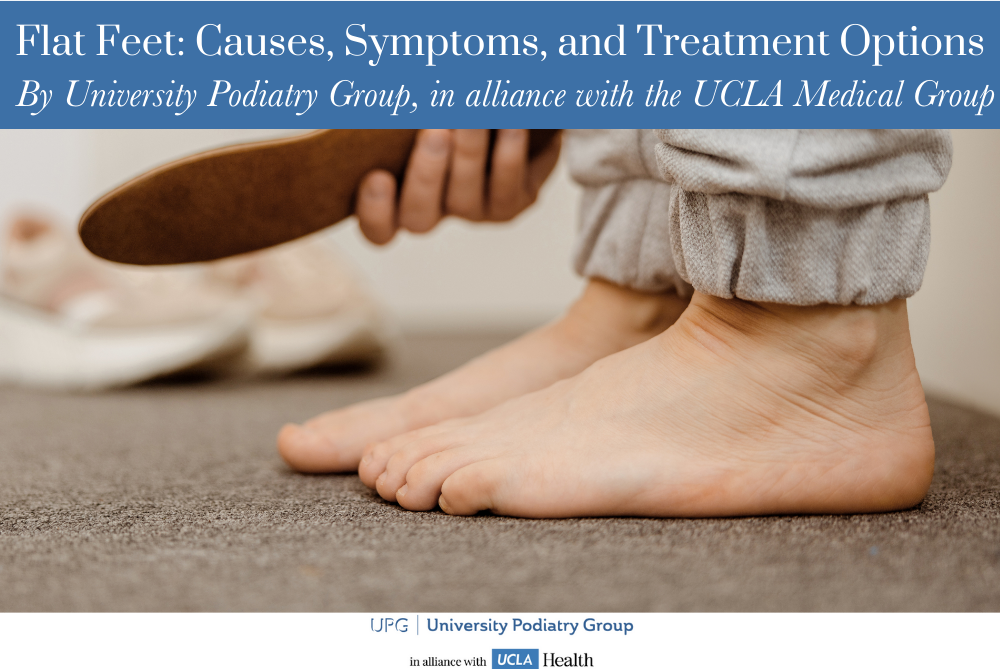
Flat feet, also known as fallen arches, is a common foot condition that affects millions of individuals of all ages. At University Podiatry Group, in alliance with the UCLA Medical Group, our expert podiatrists are committed to helping patients understand, manage, and treat flat feet through comprehensive, evidence-based care across our multiple Southern California locations.
What Are Flat Feet?
Flat feet occur when the arches of the feet collapse or never fully develop, causing the entire sole of the foot to come into complete or near-complete contact with the ground. Some individuals are born with flat feet (congenital), while others may develop the condition over time due to injury, aging, or stress on the foot structures.
There are two main types of flat feet:
- Flexible flatfoot: The arch appears when sitting but disappears when standing.
- Rigid flatfoot: The arch is always absent, regardless of whether the foot is bearing weight or not.
Causes of Flat Feet
Flat feet may result from a variety of factors, including:
- Genetics: Some individuals inherit the condition from family members.
- Injury: Trauma to the foot or ankle can damage tendons, particularly the posterior tibial tendon.
- Aging and wear: Over time, ligaments and tendons in the foot may weaken.
- Medical conditions: Diabetes, rheumatoid arthritis, or obesity can increase risk.
- Improper footwear: Wearing unsupportive shoes over long periods can contribute to arch collapse.
Common Symptoms
While some people with flat feet experience no discomfort, others may suffer from:
- Pain in the arch, heel, ankle, or lower leg
- Swelling along the inside of the ankle
- Overpronation (rolling inward of the ankle)
- Foot fatigue or difficulty standing for long periods
- Knee, hip, or back pain due to altered body alignment
If left untreated, flat feet can lead to complications such as plantar fasciitis, shin splints, or even tendonitis.
How We Diagnose Flat Feet
At University Podiatry Group, our podiatrists use a combination of:
- Physical examination: Observing the structure and movement of the foot while standing and walking.
- Imaging: X-rays, MRIs, or CT scans may be used to assess bone structure or tendon health.
- Gait analysis: Evaluating how you walk helps us identify alignment issues.
Flat Foot Treatment Options
Our personalized approach to care includes both conservative and surgical options:
Non-Surgical Treatments:
- Custom orthotics: Specially designed insoles to support the arch and relieve pressure.
- Supportive footwear: Recommending shoes with arch support and cushioning.
- Physical therapy: Exercises to strengthen the foot and ankle muscles.
- Activity modification: Avoiding high-impact sports or prolonged standing.
- Medications: NSAIDs to reduce pain and inflammation.
Surgical Options (for severe or unresponsive cases):
- Tendon repair or transfer
- Joint fusion or realignment procedures
- Calcaneal osteotomy (heel bone repositioning)
Our board-certified podiatrists discuss all available options and work closely with each patient to determine the most effective course of treatment.
Frequently Asked Questions (FAQ)
Q: Is flat foot a serious condition?
A: While flat feet are not always serious, untreated cases can lead to chronic pain, mobility issues, and joint complications.
Q: Can flat feet be fixed permanently?
A: In many cases, symptoms can be managed effectively with orthotics and lifestyle changes. For structural correction, surgery may be considered.
Q: Are children with flat feet always in need of treatment?
A: Not necessarily. Many children have flexible flat feet that improve with age. However, persistent pain or difficulty walking warrants evaluation by a podiatrist.
Q: What kind of shoes should I wear if I have flat feet?
A: Look for shoes with good arch support, firm heel counters, and shock-absorbing soles. Avoid flat sandals or high heels.
Q: Can flat feet lead to other problems?
A: Yes. They can contribute to misalignment, which may cause pain in the ankles, knees, hips, or lower back over time.
Q: Will insurance cover custom orthotics or flat foot surgery?
A: Coverage varies by provider and plan. Our team will help verify your benefits and assist with the approval process.
Why Choose University Podiatry Group?
With our affiliation with the UCLA Medical Group, patients can expect world-class care delivered by a team of leading podiatric experts. We focus on both compassionate patient service and cutting-edge treatment approaches for foot and ankle disorders. Whether you’re dealing with mild discomfort or severe flatfoot deformity, we are here to restore your comfort and mobility.
Contact Information
Westwood Office
100 Medical Plaza Driveway #460
Los Angeles, CA 90024
📞 (310) 443-8999
Santa Monica Office
2001 Santa Monica Blvd #1060
Santa Monica, CA 90404
📞 (310) 582-1940
Torrance Office
3500 Lomita Blvd Suite M100
Torrance, CA 90505
📞 (310) 517-8578
Santa Clarita Office
25775 McBean Pkwy Suite 115A
Santa Clarita, CA 91355
📞 (661) 753-5464
Porter Ranch Office
19950 Rinaldi St Suite 300
Porter Ranch, CA 91326
📞 (818) 271-2400
Westlake Village Office
1250 La Venta Drive, Suite 106
Westlake Village, CA 91361
📞 (805) 494-6920
If you or a loved one is struggling with foot pain or suspect you may have flat feet, schedule a consultation with the University Podiatry Group today. Our team is ready to help you put your best foot forward—comfortably and confidently.
